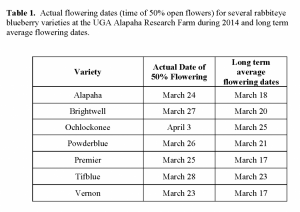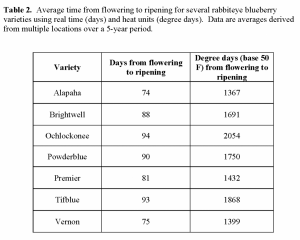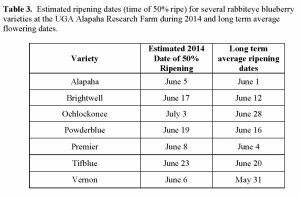By: D. Scott NeSmith
The 2014 blueberry season is underway, and the cold weather has certainly had an impact on our crop. The deep cold has been beneficial in giving a high number of chill hours; however, the length of cold has slowed warming and subsequent plant development. Therefore, at the time of this writing (April 14, 2014) we are slowly beginning to see small green fruit develop on most of our rabbiteye blueberry varieties. One of the important issues growers and marketers are trying to determine now is when will this crop ripen. Following are some comments for consideration as we try to determine when the 2014 rabbiteye crop will mature.
Several factors contribute to the rate of blueberry development from flowering to ripening. These include heat units (or degree days), amount of pollination, amount of spring leaf development, and crop load. No doubt, the cool spring weather we have experienced has slowed crop development, especially dates of flowering. Keep in mind, age of plants and degree of pruning in the previous year typically influence dates of flowering as well. Once flowers open, cool weather can also delay time of ripening. While we do not know at this time how any of these factors will ultimately affect the 2014 crop, we can make some “educated guesses” of plausible ripening times using some heat unit models we have developed in the past decade.
Table 1 below lists observed dates of 50% flowering for several important rabbiteye varieties at the Alapaha Research Farm for 2014, along with long term average dates of flowering. A casual glance reveals that most varieties were 5 to 7 days later flowering than average. Will this translate into a later ripening crop as well? It is difficult to estimate if we use only average days from flowering to ripening (Table 2). However, using charts we have developed over the past decade for fruit development period (FDP) using heat units (degree days) required for ripening (Table 2), we can make improved estimates for 2014 ripening times. We used data for heat units (degree days) obtained from the UGA weather site (https://www.georgiaweather.net) for the Alapaha location. We selected degree days, and used a base temperature of 50 F. Please note, if you use the degree days calculator on the UGA weather web page, the default is 60 F. So, you must adjust to 50 F for more accurate calculations. For time from flowering until the current date, we used actual accumulated degree days in our calculations. For time beyond our current date, we looked at multi-year average degree days accumulated for the time from April 14 (our current date) to June 1, June 15, and July 1. Using this combination of data we estimated this year’s time of ripening.
Table 3 shows our date estimates for 50% ripe fruit for several rabbiteye varieties. We have also included the long term ripening date for comparison. Similar to flowering observations, the ripening estimates suggest the 2014 season will be later than average for rabbiteye ripening, perhaps by as much as 4 to 6 days depending on variety. Keep in mind, these estimates are for 50% ripening times, and 10% “plus” ripe fruit can typically be expected 7 to 10 days earlier than the 50% ripe fruit dates. Also, the past 20 years of experience shows that the Homerville area is typically 2 to 4 days earlier than the Alapaha site, and the Alma/Baxley areas are 2 to 4 days later. Thus, growers should plan accordingly.
This information, along with estimates for the ripening of our highbush crop (not shown) indicates a potential volume gap in ripe fruit available around the last week of May in south Georgia as the highbush wind down but before the early rabbiteyes pick up. Please keep in mind, these data and their utility are not the final word on any projections for this year’s crop maturity dates and should only be considered an estimate. Extremes of warmer or cooler weather can change the estimate. Also, heavy or light crop loads can change the estimate for a particular variety. However, such data are a reasonable tool for trying to approximate when the 2014 crop will be ready. I have little doubt that the 2014 rabbiteye crop in Georgia will be later than the past 2 to 3 years. Hopefully this information will be useful.


